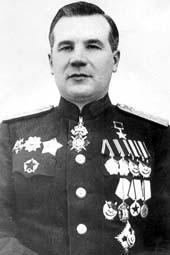Allegiance Soviet Union | Name Mitrofan Nedelin Years of service 1920 — 1960 | |
 | ||
Rank Chief marshal of the artillery Commands held 13th Artillery Regiment (1939-40)Artillery 160th Rifle Division (1940-41)4th Anti-Tank Brigade (1941)Artillery 18th Army (1941)Artillery 37th Army (1941-43)Artillery 56th Army (1943)V Artillery Corps (1943)Artillery South-Western Front (1943)Artillery 3rd Ukrainian Front (1943-45)Artillery Southern Soviet Group of Forces (1945-46)Chief Artillery Directorate (1948-50)CinC Artillery (1950-52, 1953-55)Deputy Minister of War (1952-53)Deputy Minister of Defence (1955-60)CinC Strategic Missile Force (1959-60) Similar People Mikhail Tukhachevsky, Kliment Voroshilov, Semyon Timoshenko, Kirill Meretskov, Boris Shaposhnikov | ||
Service/branch Strategic Missile Troops | ||
Mitrofan Ivanovich Nedelin (Russian: Митрофа́н Ива́нович Неде́лин) (November 9, 1902 — October 24, 1960) was a Soviet military commander who served as Chief Marshal of the Artillery in the Soviet Armed Forces. A long-time member of the Red Army, Nedelin was a veteran of numerous wars and was honored as a Hero of the Soviet Union for his service during the Second World War. On May 8, 1959, Nedelin was promoted to Chief Marshal of the Artillery, and became an important figure in the development of ICBMs and the Space Race. On October 24, 1960, Nedelin was killed in an explosion at Baikonur Cosmodrome during the eponymous Nedelin catastrophe.
Contents
Early life
Mitrofan Ivanovich Nedelin was born on November 9, 1902, in Borisoglebsk, Voronezh Governorate, Russian Empire.
Military career
Nedelin joined the Red Army in 1920, aged 18, and fought as a volunteer in the Russian Civil War until its conclusion in 1923. The following year he joined the Communist Party of the Soviet Union, and was conscripted back into the Red Army, becoming an artillery commander. From 1937 to 1939, Nedelin fought in the Spanish Civil War as a foreign volunteer for the Republican Government, and the same year was appointed to command 13th Artillery Regiment in the Soviet Red Army. In 1940 he was appointed to command the artillery of 160th Rifle Division after returning from Spain, and participated in the Winter War until 1940.
In 1941, after the Soviet Union entered World War Two, Nedelin was appointed commander of first 4th Anti-Tank Brigade, then the artillery of 18th Army, and then the artillery of 37th Army where he stayed until 1943, before being moved to command the artillery of 56th Army. In 1943, he was appointed Deputy Commanding Officer of the artillery of the Northern Caucasian Front. From there Nedelin moved to command the V Artillery Corps, and then the artillery of the south-western front, and then the artillery of the 3rd Ukrainian Front where he stayed from 1943 to 1945, playing an especially important part in the capture of Hungary. In 1945, Nedelin became assistant commanding officer and then the commanding officer of the artillery of the Soviet Southern Group of Forces.
In 1946, after the end of the Second World War, Nedelin became chief of staff of the chief artillery directorate of the Soviet Army, and then chief of staff of artillery, and then deputy commander in chief of artillery. In 1948, he became head of the chief artillery directorate of the Soviet Army before becoming commander in chief of artillery from 1950 to 1952, and after a brief period as Deputy Minister of War, returned as commander in chief of artillery from 1953 to 1955. From 1955, he was Deputy Minister of Defence, and concurrently from 1959 commander in chief of the Strategic Missile Force.
Space
During the Cold War, Nedelin inadvertently played a key role in ushering in the Space Age by concluding that rockets were the ideal means to deliver a nuclear warhead to the United States instead of bombers, and ordered Sergei Korolev to develop the massive R-7 ICBM capable of carrying a large warhead to the United States. This rocket and its derivatives, while never an effective ICBM, was powerful enough to launch Sputnik, the world's first artificial Earth satellite, and then Vostok manned space vehicles into orbit. These accomplishment allowed the Soviet Union to beat the United States on being the first nation to enter space, and taking a leading position during the early Space Race.
Death
On October 24, 1960, Nedelin, along with approximately 120 other individuals, were killed in a test rocket explosion at Baikonur Cosmodrome. The incident became known as the Nedelin catastrophe, named after Nedelin due to being its most notable victim, and was covered up by the authorities. Nedelin's death was officially listed as having occurred in a plane crash until the collapse of the Soviet Union in the 1990s uncovered the incident.
Nedelin was buried in a tomb in the Kremlin Wall Necropolis at Red Square in Moscow.
